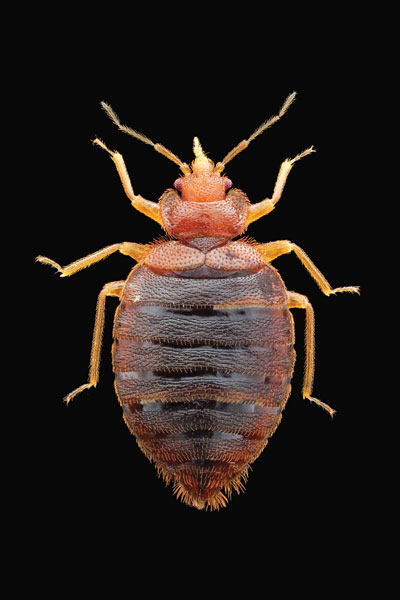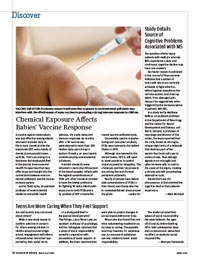In Review
 VACCINE VARIATION: Rochester research indicates that exposure to environmental pollutants may interfere with the effectiveness
of some vaccines in prompting a strong immune response in children. (Photo: Adobe Stock)
VACCINE VARIATION: Rochester research indicates that exposure to environmental pollutants may interfere with the effectiveness
of some vaccines in prompting a strong immune response in children. (Photo: Adobe Stock)A vaccine against tuberculosis was less effective among infants who were exposed early in life to toxic chemicals like the insecticide DDT and a family of chemical compounds known as PCBs. That’s according to a Rochester-led study published in the journal Environmental Health Perspectives that may offer important insight into the connections between environmental pollutants and the human immune system.
Led by Todd Jusko, an assistant professor of environmental medicine and public health sciences, the study measured immune responses six months after a TB vaccine was administered to more than 500 mother-baby pairs living in eastern Slovakia, an area heavily contaminated by environmental pollutants.
Harmful chemicals were detected in more than 99 percent of the blood samples. Infants with the highest concentrations of PCBs and other chemicals tended to have the lowest antibodies for fighting TB while infants with exposures to both PCBs and a by-product of DDT showed the lowest vaccine antibody levels.
Once widely used in manufacturing and consumer products, PCBs were banned in the United States in 1979.
Although also banned in the United States, DDT is still used in some countries to control malaria spread by mosquitos. The chemicals and their by-products are among the world’s most persistent pollutants.
Nearly all people have detectable concentrations of PCBs in their blood, even those who live in nonindustrialized areas around the globe. —Leslie Orr
Study Details Source of Cognitive Problems Associated with MS
The question of why many patients with multiple sclerosis (MS) experience a slow and continuous cognitive decline may have new answers.
Rochester research published in the Journal of Neuroscience indicates that a subset of brain cells which are normally activated to fight infection, defend against assaults on the nervous system, and clean up debris from damaged cells may act too aggressively when triggered by the immune system in patients with MS.
In a study led by Matthew Bellizzi, an assistant professor in the Department of Neurology and the Center for Neural Development and Disease, and Harris Gelbard, a professor of neurology and director of the center, the team reported that the cells, known as microglia, release high levels of a molecule that destroys part of the system that brain cells use to communicate. That damage signals more microglia and other immune cells to rush to the scene of the injury, creating a chronic and self-perpetuating destructive cycle.
Researchers say the phenomenon is likely behind the cognitive decline that patients experience.
—Mark Michaud
Teens Are More Caring When They Feel Support
Are adolescents less concerned about others?
While a new study seems to confirm a decline in concern for others among children in middle school and early high school, engagement with others rebounds when teens feel supported by their social circle.
In a study published in the journal Developmental Psychology, Laura Wray-Lake, an assistant professor of psychology, and her colleagues reported that a sense of social responsibility varied in conjunction with perceptions of social support. In addition, the team reported they were able to predict changes in social responsibility over time.
Wray-Lake also found that over time, volunteering resulted in an increase in caring. The opposite was true, however, for substance use. An increase in substance use was related to lower social responsibility.
The study indicated that values of social responsibility decrease between the ages of 10 and 16, before leveling off in later adolescence. Race and socioeconomic status had no effect on students’ social responsibility.
—Monique Patenaude
Getting Intimately Acquainted with the Common Bed Bug
 BYE-BYE, BEDFELLOWS? An effort to map the genome of the common bed bug may point researchers toward more effective ways to
combat the insects, say Rochester scientists. (Photo: Graham Snodgrass/Armed Forces Pest Management Board)
BYE-BYE, BEDFELLOWS? An effort to map the genome of the common bed bug may point researchers toward more effective ways to
combat the insects, say Rochester scientists. (Photo: Graham Snodgrass/Armed Forces Pest Management Board)With the resurgence of bed bugs, people around the world are getting more familiar with the creatures than they’d like. But John Werren, the Nathaniel and Helen Wisch Professor of Biology, and fellow researchers have really gotten up close and personal, successfully mapping the genome of Cimex lectularius to get a better understanding of its genetic makeup.
They’ve done it with an eye toward eradicating the parasite, which feeds on human and animal blood. The findings, by researchers from 36 institutions, were published in the journal Nature Communications.
While the genomes of many insects have been sequenced, Werren says the bed bug’s genetic makeup is particularly interesting “because it’s a human parasite, a major pest, and has a unique biology.” In his arm of the project, Werren discovered more than 800 possible instances of genes being transferred from bacteria within the bed bug to the insect’s chromosomes. Most transferred genes never become functional, but one exception—a gene from the Wolbachia bacteria—appears to be functional in male bed bugs. That may create a potential target for more effective pest control, he says, though much work remains to be done.
—Peter Iglinski

